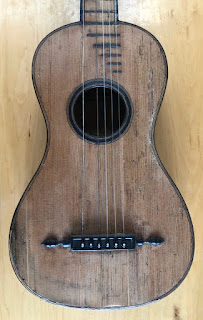In Auckland New Sealand the birth of this guitar
took place. It has been built in 2000 by Rod Capper.
He gave it the name "Celaje" which means "Painting
of the sunrise" very poetic indeed. It is in now good
condition and has a warm and friendly tone.
The back and sides of this guitar have been executed
with Indian rosewood. Rod Capper is known to use
native woods as the climate in New Zealand allows
it to grow useable hardwoods there. The bridge has
been made out of a native wood called Jarra. Maybe
not visible on this picture the back is showing some
deep carvings on this furthermore very nice looking
instrument. Together with the relaquering of the back
the frets will be dressed and the fingerboard will be
flattened out if needed.
The headstock that likely is provided with Schaller tuners
to my believe. They do their job very well. This guitar will
also be equipped with an ivory topnut as string spacing
in fact is a bit of a personal one and I like slightly more
"room" between the first string and the outer end in order
to be able to make a proper pull off execution.
The rosette is quite intriguing as it is very refined.
Though the combination with the darker cedar would
ask for another color setting to my opinion it remains
a remarkable one. My taste for Rosettes is personal
of course.
Under his label he placed another smaller label where
one can find his signature. On the bigger label one can
find the year and month of production: May 2000.
The number is 5 so it probably was the fifth guitar
in that year. In an E-mail states Mr. Capper this to
be a concert instrument and it has those qualities.
By clicking on this picture you are able to study the
bottom of the bridge slot which is surprisingly V
shaped. According to Rod this is to increase the
contact area and thus boosting the energy transport
of the strings to the body.
I think it will not be very surprising but to bring a guitar
back in an immediately playable condition and have the
lacquer brought back in a like new condition asks for
some hours investigating. But the guitar is worth all
that additional work. Of course a good set of strings
will be the final move on this instrument that normally
finds itself in the 5000 Euro's price range.
Augustin Claudot
This french early romantic guitar has been built
by Augustin Claudot who was a member of the
well known Claudot Family of violin makers at
Mirecourt. Though affected by wood insects this
particular instrument still has a wonderful sound.
Mirecourt. Though affected by wood insects this
particular instrument still has a wonderful sound.
This picture clearly shows us the soundboard before
restauration. In fact I was forced to make some radical
decisions regarding reparation. It all worked out very
well! As you will understand: Not my daily guitar.
done with maple as are the sides of this instrument.
This whole instrument has been treated with
Gamma rays in order to kill eventually existing
insects. It should last now for the future.
or branded his instruments. His violins are said to be
made with nice woods and great craftsmanship. This
guitaris not a one of a kind as the guitar museum in
Mirecourt holds an exactly the same looking instrument!
that there are no bones used. The neck angle has to be
perfect in order to be able to have a comfortable
playability. That is still present to these days.
Ivory knobs had to be there as was original.
The same counts for the ivory inlaid fretwork.
Sitll a beautiful figured maple back
The soundboard that suffered from wood insects but
still absolutely straight which was a pleasant surprise.
Not the entitre soundboard but some spots look worse.
The same counts for the back but this is the only worse
spot on the back and not that vital for the strength of
the guitar.
A better and a more worse part with inlay.
In fact this instrument was praised for the beautiful and
original bridge. No bridgebone but in ebony executed.
A simple soundhole decoration and
ebony wood for the highest frets
Maybe someone tried to fill the small holes in the past
but there are certainly better alternatives though they
all will affect the sound the way it is now.
The inlay on these edges could have been done
better. But that is not a big issue to repair.
The fingerboard indeed is rounded as it came
to us this way. Most likely original as Augustin
Claudot was better known as a violin luthier.
The bottom of the guitar has an ebony inlay. You are
able to take look at the firmly glued bridge as well.
A rather small instrument, but: Total Length: 90 cm
Scale length: A surprising 642 mm Width topnut: 47 mm
Newly added tuning keys.
The head of this guitar that probably has been
veneered quite recently.
Most likely the back has been painted and/or sprayed.
The neck is absolutely straight and has been veneered
with ebony as was common on higher end instruments.
The outer heel still fits perfectly to the body.
The side are not bad at all with only one insert near the heel.
And the other side. You are able to enlarge the pictures
by clicking on them.
A rather big soundhole for such a small bodied guitar.
A finherboard in line with the soundboard as was
common untill appr. 1840.
And the bottom of this guitar. A exact second example
of this instrument can be seen in the Mirecourt museum
in France and maybe even on their website.





































Geen opmerkingen:
Een reactie posten